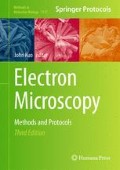Abstract
More than 30 years ago two groups independently reported the vitrification of pure water, which was until then regarded as impossible without a cryoprotectant [1, 2]. This opened the opportunity to cryo-electron microscopy (cryo-EM) to observe biological samples at nanometer scale, close to their native state. However, poor electron penetration through biological samples sets the limit for sample thickness to less than the average size of the mammalian cell. In order to image bulky specimens at the cell or tissue level in transmission electron microscopy (TEM), a sample has to be either thinned by focused ion beam or mechanically sectioned. The latter technique, Cryo-Electron Microscopy of Vitreous Section (CEMOVIS), employs cryo-ultramicrotomy to produce sections with thicknesses of 40–100 μm of vitreous biological material suitable for cryo-EM. CEMOVIS consists of trimming and sectioning a sample with a diamond knife, placing and attaching the section onto an electron microscopy grid, transferring the grid to the cryo-electron microscope and imaging. All steps must be carried on below devitrification temperature to obtain successful results. In this chapter we provide a step-by-step guide to produce and image vitreous sections of a biological sample.
Access this chapter
Tax calculation will be finalised at checkout
Purchases are for personal use only
References
Bruggeller P, Mayer E (1980) Complete vitrification in pure liquid water and dilute aqueous-solutions. Nature 288:569–571
Dubochet J, Mcdowall AW (1981) Vitrification of pure water for electron-microscopy. J Microsc (Oxford) 124:Rp3–Rp4
Al-Amoudi A, Norlen LPO, Dubochet J (2004) Cryo-electron microscopy of vitreous sections of native biological cells and tissues. J Struct Biol 148:131–135
Al-Amoudi A, Chang JJ, Leforestier A et al (2004) Cryo-electron microscopy of vitreous sections. EMBO J 23:3583–3588
Al-Amoudi A, Dubochet J, Studer D (2002) Amorphous solid water produced by cryosectioning of crystalline ice at 113 K. J Microsc (Oxford) 207:146–153
Al-Amoudi A, Studer D, Dubochet J (2005) Cutting artefacts and cutting process in vitreous sections for cryo-electron microscopy. J Struct Biol 150:109–121
Hsieh CE, Leith A, Mannella CA et al (2006) Towards high-resolution three-dimensional imaging of native mammalian tissue: electron tomography of frozen-hydrated rat liver sections. J Struct Biol 153:1–13
Hsieh CE, Marko M, Frank J et al (2002) Electron tomographic analysis of frozen-hydrated tissue sections. J Struct Biol 138:63–73
Norlen L, Oktem O, Skoglund U (2009) Molecular cryo-electron tomography of vitreous tissue sections: current challenges. J Microsc (Oxford) 235:293–307
Pierson J, Fernandez JJ, Bos E et al (2010) Improving the technique of vitreous cryo-sectioning for cryo-electron tomography: electrostatic charging for section attachment and implementation of an anti-contamination glove box. J Struct Biol 169:219–225
Pierson J, Ziese U, Sani M et al (2011) Exploring vitreous cryo-section-induced compression at the macromolecular level using electron cryo-tomography; 80S yeast ribosomes appear unaffected. J Struct Biol 173:345–349
Sader K, Studer D, Zuber B et al (2009) Preservation of high resolution protein structure by cryo-electron microscopy of vitreous sections. Ultramicroscopy 110:43–47
Al-Amoudi A, Diez DC, Betts MJ et al (2007) The molecular architecture of cadherins in native epidermal desmosomes. Nature 450:832–837
Gruska M, Medalia O, Baumeister W et al (2008) Electron tomography of vitreous sections from cultured mammalian cells. J Struct Biol 161:384–392
Al-Amoudi A, Dubochet J, Gnaegi H et al (2003) An oscillating cryo-knife reduces cutting-induced deformation of vitreous ultrathin sections. J Microsc (Oxford) 212:26–33
Kukulski W, Schorb M, Welsch S et al (2011) Correlated fluorescence and 3D electron microscopy with high sensitivity and spatial precision. J Cell Biol 192:111–119
Masich S, Ostberg T, Norlen L et al (2006) A procedure to deposit fiducial markers on vitreous cryo-sections for cellular tomography. J Struct Biol 156:461–468
Dubochet J, Zuber B, Eltsov M et al (2007) How to “read” a vitreous section. Methods Cell Biol 79:385–406
Blanc NS, Studer D, Ruhl K et al (1998) Electron beam-induced changes in vitreous sections of biological samples. J Microsc (Oxford) 192:194–201
Aronova MA, Sousa AA, Leapman RD (2011) EELS characterization of radiolytic products in frozen samples. Micron 42:252–256
Quispe J, Damiano J, Mick SE et al (2007) An improved holey carbon film for cryo-electron microscopy. Microsc Microanal 13:365–371
Ermantraut E, Wohlfart K, Tichelaar W (1998) Perforated support foils with pre-defined hole size, shape and arrangement. Ultramicroscopy 74:75–81
Author information
Authors and Affiliations
Editor information
Editors and Affiliations
Rights and permissions
Copyright information
© 2014 Springer Science+Business Media, New York
About this protocol
Cite this protocol
Chlanda, P., Sachse, M. (2014). Cryo-electron Microscopy of Vitreous Sections. In: Kuo, J. (eds) Electron Microscopy. Methods in Molecular Biology, vol 1117. Humana Press, Totowa, NJ. https://doi.org/10.1007/978-1-62703-776-1_10
Download citation
DOI: https://doi.org/10.1007/978-1-62703-776-1_10
Published:
Publisher Name: Humana Press, Totowa, NJ
Print ISBN: 978-1-62703-775-4
Online ISBN: 978-1-62703-776-1
eBook Packages: Springer Protocols

